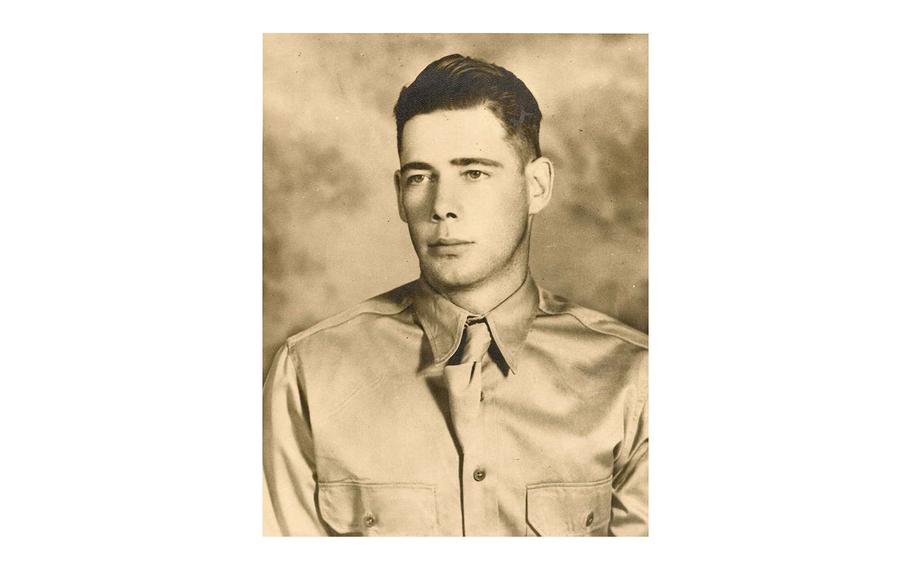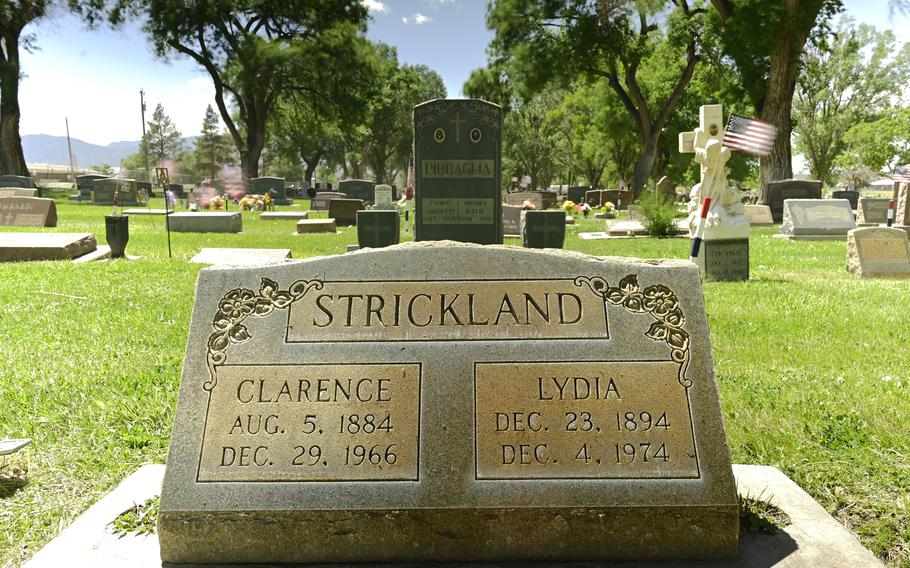
World War II Army veteran Clifford H. Strickland. (Defense POW/MIA Accounting Agency)
(Tribune News Service) — On the last Tuesday in December, Jacque VanBuskirk received the phone call her family had awaited for generations — the remains of an uncle she’d never met, a World War II prisoner of war who had been considered missing in action for almost 82 years, finally had been identified.
The body of 25-year-old Clifford H. Strickland, a U.S. Army technician 5th grade from Fowler in southeastern Colorado, was officially identified five years after being exhumed from a Philippines cemetery, where he and other POWs had been reburied as unknown soldiers following the end of the war.
Next month, Strickland’s remains will finally be returned home to Colorado, where they will be laid to rest in the same cemetery as his mother and father.
“It’s just like a piece of you is missing and you don’t know where it is,” said VanBuskirk, 65, who lives in Arizona. “It’s exciting, but at the same time, it’s sad because we’re planning a memorial and funeral for my uncle. But at the same time, he’s coming home and will be buried near his parents.”
This Memorial Day, Strickland’s family is one of at least four to receive news in recent months that the bodies of their long-missing Colorado soldiers had been formally identified. The remains of Army Cpl. John A. Spruell, from Cortez, who went missing during the Korean War; and Army Staff Sgt. Harold A. Schafer, from Denver, and Army Private James B. McCartney, from Ridgway, both killed in World War II, are among those newly identified.
Strickland enlisted in April 1940, before the United States entered World War II. Initially stationed as a mule driver at Hickam Field in Hawaii, he later was assigned to Company C, 803rd Engineer Battalion and arrived in Luzon, at the northern end of the Philippines, in October 1941, according to his family. In December 1941, Japanese troops invaded Luzon and, four months later, U.S. forces in Bataan surrendered.

Clarence and Lydia Strickland’s gravestone at Union Highland Cemetery in Florence, Colorado, on Thursday, May 23, 2024. The remains of their son, U.S. Army Technician 5th Grade Clifford H. Strickland, who died as a prisoner of war in World War II, have been officially identified and will be buried in the Florence cemetery this summer. (Hyoung Chang, The Denver Post/TNS)
The Japanese captured thousands of U.S. and Filipino service members as prisoners of war, Strickland among them.
Strickland and his fellow prisoners endured a 65-mile trek through the Philippines, known as the Bataan Death March, before arriving at Camp O’Donnell. During the five-day journey, troops were starved, beaten and stabbed with bayonets.
“Camp O’Donnell was the first camp that the prisoners were taken to,” said Gregory Kupsky, a historian assigned to Strickland’s case by the Defense POW/MIA Accounting Agency. “But the death rate was so high that the Japanese ultimately made the decision to close that camp and move most of the prisoners to Cabanatuan instead.”
More than 2,500 POWs, including Strickland, died in the Cabanatuan prison camp during World War II, according to the federal agency.
In June 1942, records show Strickland was admitted to the Cabanatuan hospital with dysentery and malaria. He died a month later and was buried by his fellow prisoners with 11 other soldiers in an unmarked grave — Common Grave 215 — according to burial records created by Cabanatuan prisoners.
“The summer was really bad in terms of death rate,” Kupsky said. “You had dozens of people dying per day and the way the burials worked is the Japanese would assign work details, and then prisoners, who themselves were in really bad shape, are carrying remains out and digging trenches to bury them in. …and they weren’t allowed to mark the graves, so it was very hard to keep track of who was buried where throughout this process.”
Learning from letters, photos and memories
Although VanBuskirk never knew her uncle — no living members of her family met him — she became acquainted with the veteran through stories, photos and memories passed from generation to generation.
“They had talked about him being quiet or somber and he was known for his ability to whisper,” VanBuskirk said.
In 2017, VanBuskirk’s cousin found a suitcase containing 20 letters Strickland sent home during his time in the Army. In the letters, Strickland recorded poetry written by fellow soldiers, snippets of his life in the Army and subtle jokes.
“What was interesting, that I know about him now, that I didn’t know about him as I was growing up, was that from his letters, he was kind of a jokester,” VanBuskirk said.
“I’m getting to be a full sleepy head, I sleep about 12 hours per day now. I suppose that when I come home I will be too lazy to work so I will have to get back in the Army again,” Strickland wrote in one letter. “The Army is the easiest job a man can get.”
Twelve years ago, VanBuskirk’s family provided the U.S. Army with their first DNA sample, in hopes that it could eventually be used to identify Strickland.
Since 2015, Kupsky and other POW agency representatives working to identify soldiers buried at Cabanatuan have met with the family almost every year, updating them on the disinterment and analysis process.
Following the end of World War II, personnel from the American Graves Registration Service exhumed the POWs buried at Cabanatuan and moved their remains to a U.S. military mausoleum near Manila, according to the Defense Department. The service examined the remains in 1947 but was only able to identify five of the POWs who had been buried in Common Grave 215. The rest were reburied as unknowns at the Manila American Cemetery and Memorial.
In 2018, after an exhaustive approval process, the Defense POW/MIA Accounting Agency’s archeologists and anthropologists once again exhumed the remains that had been in Common Grave 215. They were brought from Manila to the agency’s lab in Hawaii for analysis.
Kupsky said the POW agency had a general idea of who had been buried in Common Grave 215, thanks to information pieced together from hospital admittance documents and burial logs created by other prisoners. Records from after the war also linked Strickland to the grave.
“The tricky part with all of these cases is it’s like a puzzle with a lot of pieces missing and you don’t know which pieces you’re going to end up with. You don’t know how much of the story you’ll be able to reconstruct,” Kupsky said. “All you can do is build as much as you can and hope that your colleagues can fill in the rest.”
‘They all ended up with a hole in their heart’
Strickland’s remains were confirmed Dec. 20 and are among the more than 60 identified so far as part of the Cabanatuan project. Kupsky and other representatives from the POW agency, as well as personnel from the Armed Forces DNA Identification Laboratory and the Army Casualty Office, met with VanBuskirk and her family in February.
“They had made new dog tags for Clifford Strickland,” Kupsky said of the family. “And one of the family members gave me a hug and gave me my own dog tag of his.
“It’s extremely rewarding to be able to know that we were able to reconstruct parts of their stories that had been lost,” he added. “And in addition to that, be able to give closure to the families and give their loved ones back to be buried with their name on their grave.”
In June, Strickland’s great nephew, Air Force Capt. Daniel Strickland, will escort the remains back to Colorado from Hickam Air Force Base at Pearl Harbor for a full military funeral.
“It has been almost 10 years since we filed with the DPAA,” VanBuskirk said, referring to the Defense Department’s POW agency. “And all of the family before had passed and he hadn’t been identified or recovered, so they all ended up with a hole in their heart that just wasn’t fixable. Now it’s a healing of the heart for so many of us.”
On June 29, almost 82 years after his death, Strickland will be laid to rest near his parents at the Union Highland Cemetery in Florence, near where he grew up.
“Now don’t scorn the soldier but clasp him by the hand, for the uniform he wears means protection to our land,” Strickland penned in a 1941 letter, relaying a poem written by an unknown soldier. “The government picks its soldiers from the million far and wide, so please place him as your equal, good buddies side by side. When a soldier goes to battle you cheer him on the way, and you say he is a hero when in the ground he lay…”
©2024 MediaNews Group, Inc.
Visit at denverpost.com.
Distributed by Tribune Content Agency, LLC.